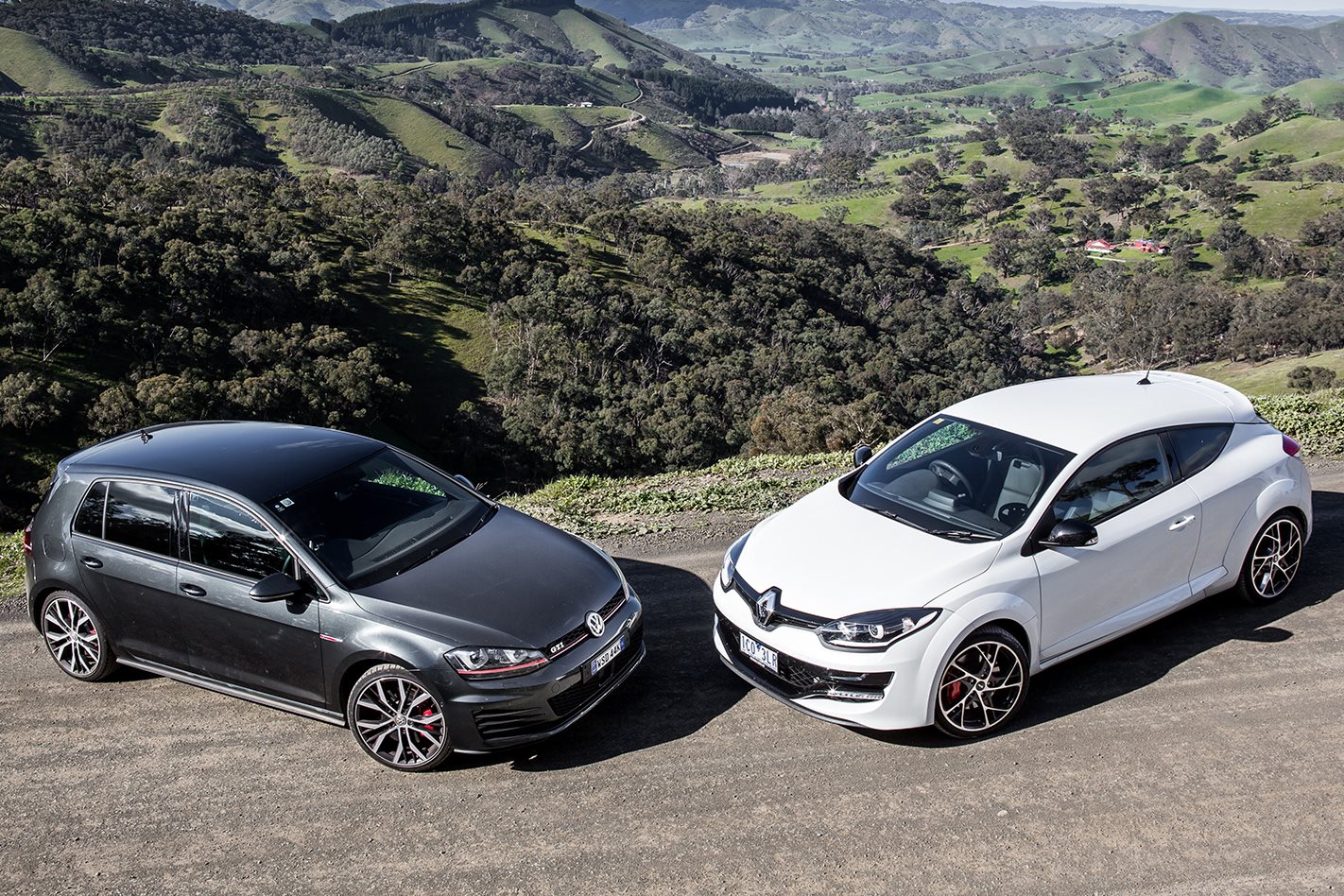This is your future.
This story was originally published in our October 2014 issue
I shall not dwell on the politics of abandoning our indigenous car-building industry, nor will I bore you with my views on losing home-grown performance heroes over the next year or two. But I will say, again, welcome to the future of performance cars.
I’m reminded of this as I drone up the Hume Highway towards Heathcote Park dragstrip, purely because the last few times I’ve made this trek it’s been in a large-capacity, local V8, with the plan to run it down the strip and write down some numbers. Not this time. Maybe not ever again.
Cars like the Golf GTI and Renault Megane 265, meantime, are the future. They’re the cars you and I and any other Aussie performance fan will be buying because, soon, they’ll be the best fast cars you can get for sensible money – if they’re not already.
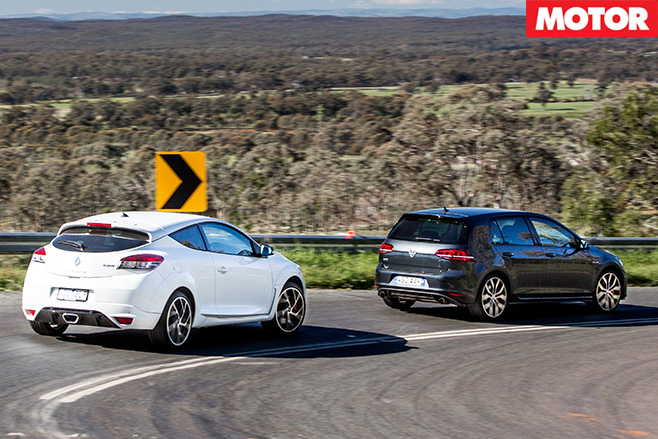
In the past, we were able to forgive the Golf GTI its DSG foibles and the Renault its wayward ergonomics because we all looked at these things as toys (well, some of us, anyway). But now that they’re about to become a bigger player to all men and women with a need for speed, can we continue to cut them this slack?
More specifically, with the latest updates to each vehicle, do those shortfalls even exist anymore? It’s a big responsibility, I tells ya.

For $4000 on top of the basic GTI’s price, the Performance package gets you R-spec brakes with 340mm rotors up front and 310mm down back, up 28mm and 10mm respectively over the GTI’s stoppers. Inside, you get Alcantara trim pieces for the tartan seats, the bi-Xenon headlights and LED tail-lights from the Golf R and another 7kW under the hood (for a total of 169kW).
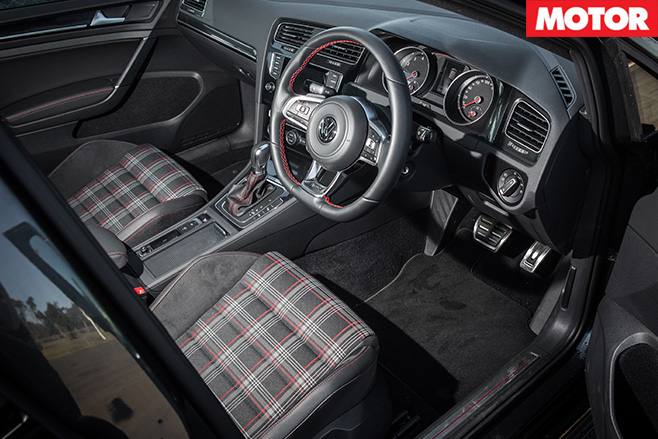
But the biggest news is the addition of an electronically-controlled mechanical limited-slip front diff, replacing the mechanical version. VW says the computer-controlled diff interfaces with the car’s ESP and other electronic traction aids and leads to a quicker, more accurate distribution of torque to the wheel with most grip, including the ability to funnel 100 per cent of drive to one wheel if conditions warrant it.
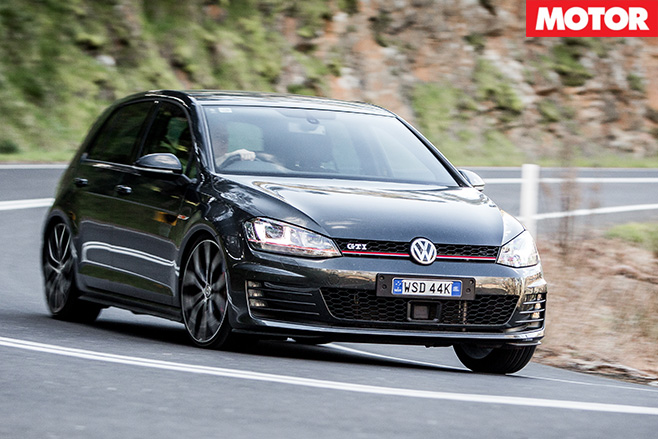
While VW has been busy expanding its GTI range, Renault has gone the other way, shrinking the Megane Sport 265 to a two-car line-up. Specifically, the Trophy and Trophy Plus models have been combined into this car, now called the Premium Cup.
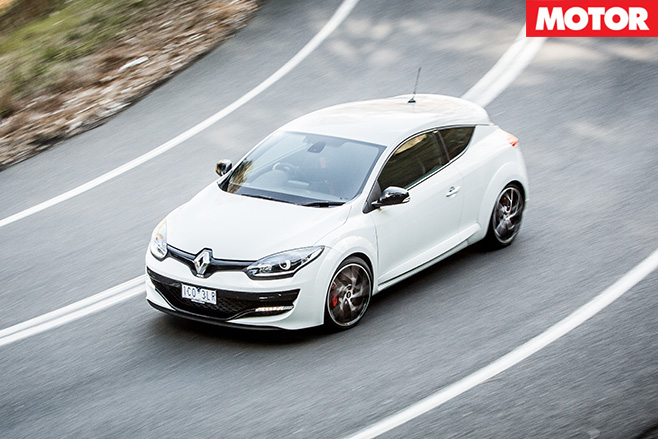
First stop, Heathcote Park dragstrip and I’m curious to see what, if any difference the new diff makes to the Golf’s habit of axle-tramping like a demented jackhammer. None, as it turns out. This also makes launch control useless because it’s not grip that limits things, it’s how far into the bump-stops the front end is pummelling itself. Am I glad these ain’t my driveshafts!
The trick, it turns out, is to ignore the launch control stuff and try to walk the car off the line with a progressive tip-in.
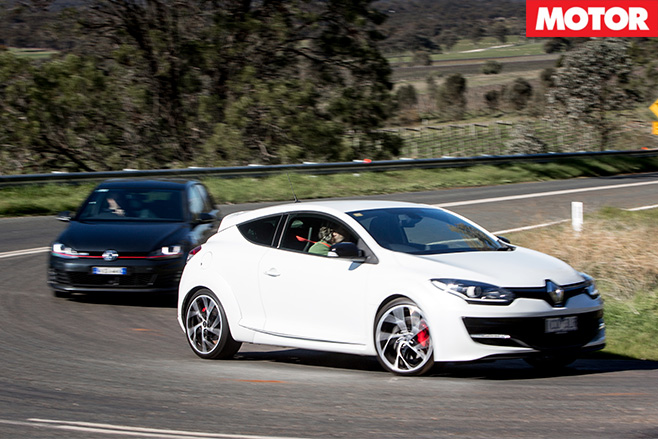
Into the Renault and you’re suddenly aware the French car has a fair bit more top-end thrust and extra willingness to tag the limiter (there’s a little light and a chime that goes off milliseconds before the ignition cut steps in). And, it’s a manual which, unusually, makes it easier to launch.
It axle-tramps, too, but you can feed the clutch and power in together, wait ’til the clutch and tyres have bitten and then feed it some more jandal (thank you Scotty Mac). Again, it’s a balancing act to get it j-u-s-t right, but if you do, say hello to 14.6 seconds at 161.6km/h. Nought to 100 takes 6.7 versus the VW’s 6.8, so it’s only the extra top-end rush that’s the difference.
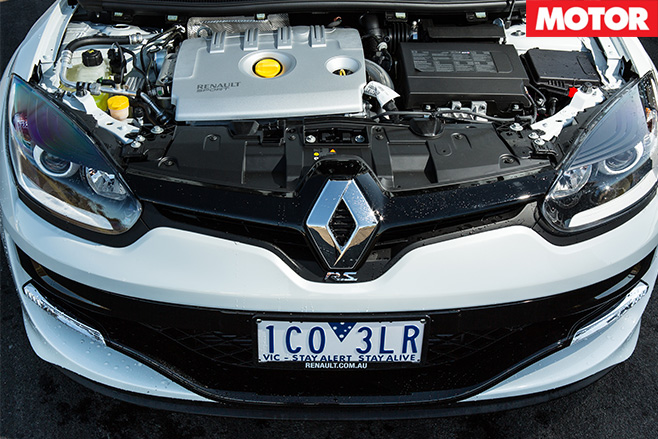
The Renault’s mill is also a bit smoother both in outright terms and just ambling along.
The VW feels a bit grumpy at times because it’s overly keen to get into a taller gear sooner (to nail a fuel consumption number, no doubt). True, you can move the drive-mode to Sport, but then it’s too manic for the road and wants to hold each gear to redline – useless in a Safeway car park.
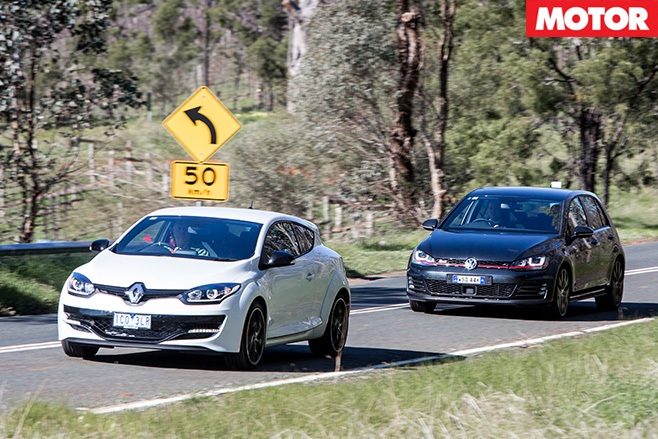
But if you want to talk feel, then let’s discuss steering. Okay, so VW has had a better handle on electric power-steering than anybody else at this end of the market for years.
Nothing’s changed. The Renault’s not bad, but it’s assisted by electricity rather than hydraulics and there’s a distinct smell of rigor-mortis at the straight ahead. Tip it in and it brightens up, but even then, there’s an artificial feel.
In isolation, you mightn’t grizzle, but jump from the Megane into the Golf and it’s a revelation. The GTI not only feels lighter through the tiller, there’s better off-centre response and heaps more realism to the experience.
And the Golf’s tricky diff? Well, if you need a reason to spend another $4000 on a VW hatch, this diff is it. Jam the Renault into a corner and its front-end bites initially in a way most front-drive cars will only dream about.
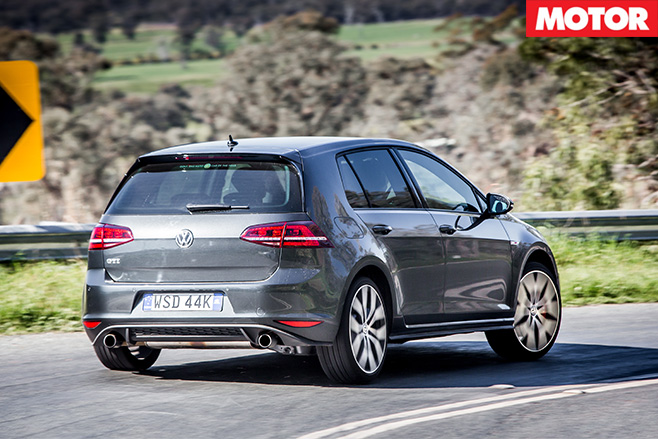
The GTI, though, rewrites the book on this stuff. You can still make it wash wide under centrifugal force if you enter a roundabout too quick, but once you’ve got the thing lined up with the apex, you can bang home the juice with a fair bit of abandon. If you’ve overdone it, you’ll feel a slight hesitation as the traction control detects a looming crash.
But instead of pulling the pin on the fuel and spark right there, the VW goes to Plan B which is to have the ESC tell the diff to get off its butt and shift anything up to 100 per cent of the torque to the outside wheel. At which point the power comes on hot and strong and the car drives itself around its inside front wheel. Brilliant.
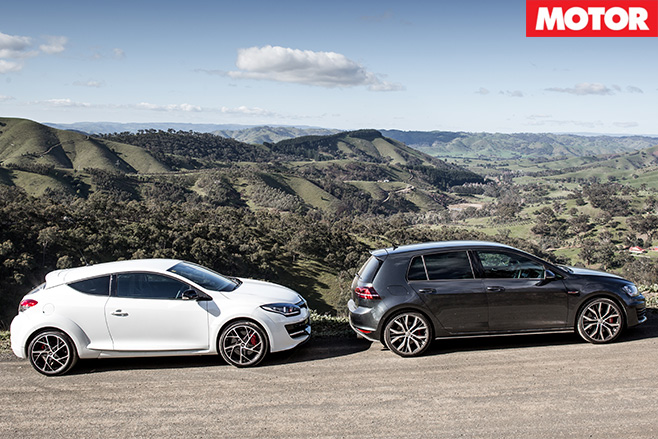
Why it works is simple: post-apex understeer in a car like this is a function of too much grunt and not enough grip. Traditionally, ESC systems have fixed it by limiting the grunt side of the equation. The new GTI comes from the other direction and fixed the grip element, allowing the grunt to remain. And because of the diff-electronics interface, it happens much faster in this set-up. You’ll be seeing more of this.
On the road, both cars have a fair bit of ride compromise thanks to sidewall-less 19-inch tyres (Dunlops on the VW, Contis on the Ren). Even setting the driver mode to comfort in the Golf doesn’t help much – at least the German is sensible in its layout and specification.

At normal operating temperature, the needle on the temp gauge obscures the temp symbol, leaving you wondering what that gauge is reading. The cruise-control main switch is in the centre console between the seats and needs to be turned off so sports mode can be selected. There is one cup holder but it’s proportioned and positioned such that it’s not worthy of the name. I could go on.
On the other hand, the Golf’s boot is smaller (although the opening is bigger) and Renault has the better looking seats (but they’re both good to sit in) and a conventional park-brake.
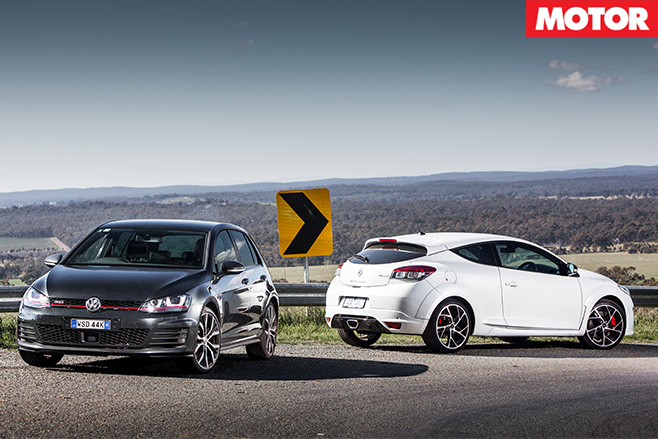
Like I said at the start of this, welcome to the future. Turns out it ain’t so bad after all.
| u00a0 | u00a0 | Volkswagen Golf GTi Performance | u00a0 | Renault Megane RS 265 Premium Cup |
| Body | u00a0 | 4-door, 5-seat hatch | u00a0 | 2-door, 5-seat hatch |
| Drive | u00a0 | front-wheel | u00a0 | front-wheel |
| Engine | u00a0 | 1984cc, inline-4, DOHC, 16v, turbo | u00a0 | 1998cc, inline-4, DOHC, 16v , turbo |
| Bore/Stroke | u00a0 | 82.5 x 92.8mm | u00a0 | 82.7 x 93.0mm |
| Compression | u00a0 | 9.6:1 | u00a0 | 8.6:1 |
| Power | u00a0 | 169kW @ 4700-6200rpm | u00a0 | 195kW @ 5500rpm |
| Torque | u00a0 | 350Nm @ 1500-4600rpm | u00a0 | 360Nm @ 3000rpm |
| Power/Weight | u00a0 | 124kW/tonne | u00a0 | 142kW/tonne |
| 0-100km/h | u00a0 | 5.8sec (tested) | u00a0 | 5.9sec (tested) |
| Top speed | u00a0 | 255km/h (tested) | u00a0 | 248km/h (tested) |
| Consumption | u00a0 | 6.4L/100km (claimed) | u00a0 | 7.5L/100km (claimed) |
| CO2 Emissions | u00a0 | 149g/km (claimed) | u00a0 | 174g/km (claimed) |
| Transmission | u00a0 | 6-speed DSG | u00a0 | 6-speed manual |
| Weight | u00a0 | 1364kg | u00a0 | 1374kg |
| Suspension | u00a0 | struts, coil springs, anti-roll bar (f); multi-links, coil springs, anti-roll bar (r)u00a0 | u00a0 | struts, coil springs, anti-roll bar (f); torsion beam, coil springs, anti-roll bar (r) |
| L/W/H | u00a0 | 4268/1790/1442mm | u00a0 | 4299/1848/1435mm |
| Wheelbase | u00a0 | 2631mm | u00a0 | 2636mm |
| Tracks | u00a0 | 1538/1516mm (f/r) | u00a0 | 1588/1545mm (f/r) |
| Steering | u00a0 | electrically-assisted rack and pinion | u00a0 | electrically-assisted rack and pinion |
| Brakes | u00a0 | 340mm ventilated discs, single-piston calipers (f); 310mm discs, single-piston calipers (r)u00a0 | u00a0 | 340mm ventilated discs, four-piston calipers (f); 290mm solid discs, single-piston calipers (r) |
| Wheels | u00a0 | 19 x 7.5-inch (f/r) | u00a0 | 19 x 8.25-inch (f/r) |
| Tyres | u00a0 | 225/35 R19 Dunlop Sport Maxx GT (f/r) | u00a0 | 235/35 R19 Continental ContiSportContacts (f/r)u00a0 |
| Price | u00a0 | $48,490 | u00a0 | $47,990 |
| Positives | u00a0 | Takes the GTI concept to a whole new dimension; new hatch king | u00a0 | Still one of the best front drivers thereu2019s ever been; faster than GTI |
| Negatives | u00a0 | Canu2019t have a manual; firm ride on 19s | u00a0 | Can be tiring day-to-day |

